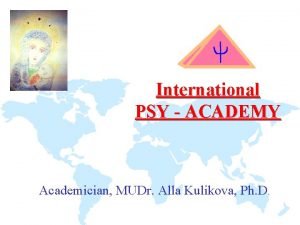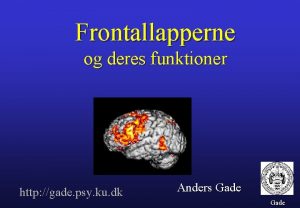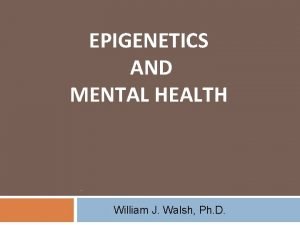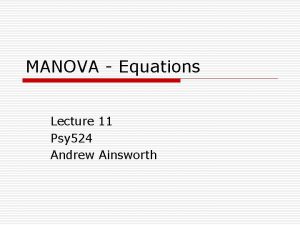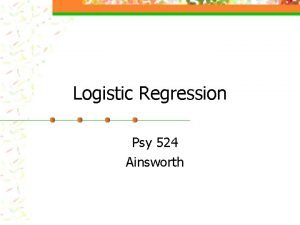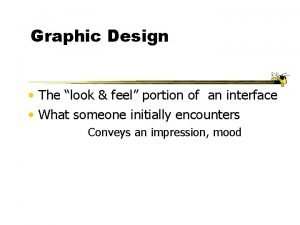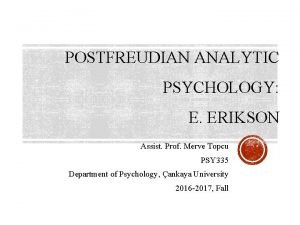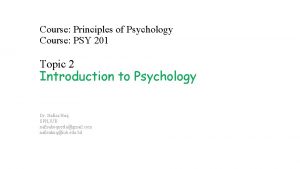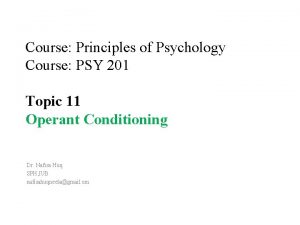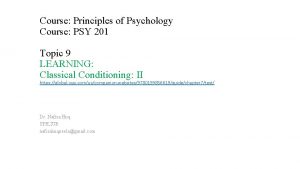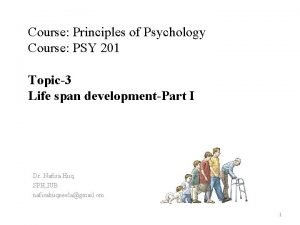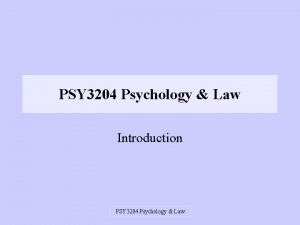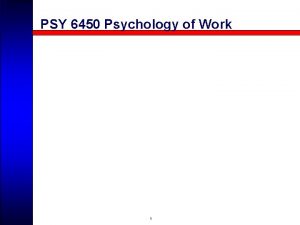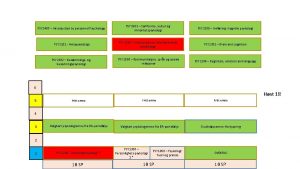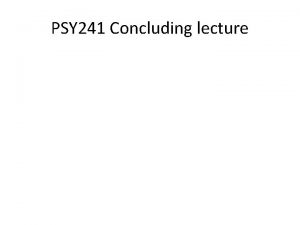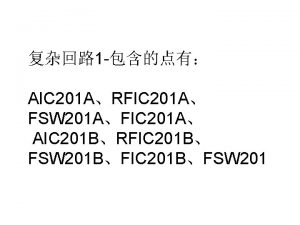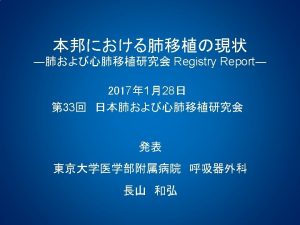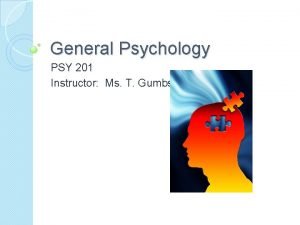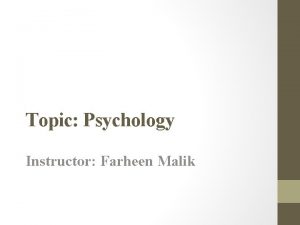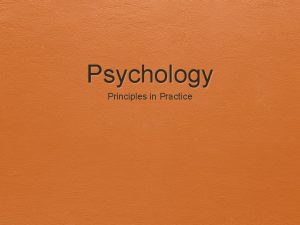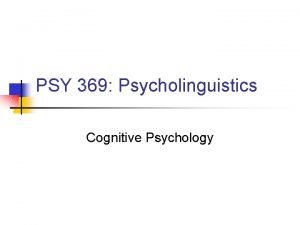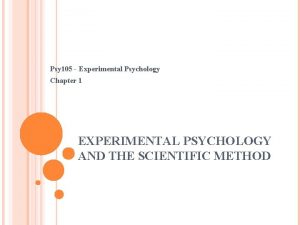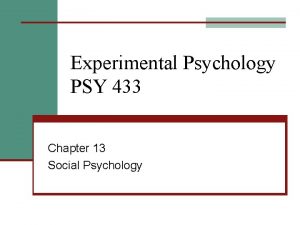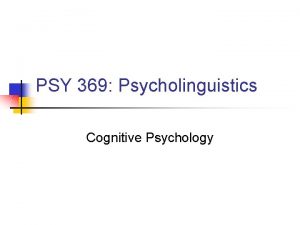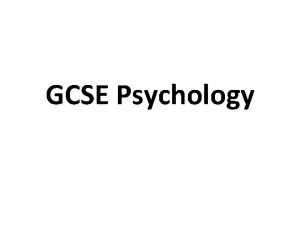Course Principles of Psychology Course PSY 201 Topic



























- Slides: 27

Course: Principles of Psychology Course: PSY 201 Topic 6 Neuroscience and Behavior-II Dr. Nafisa Huq SPH, IUB nafisahuqneela@gmail. om

Thalamus

Functions of the brain stem • Breathing center • Circulation center • Digestion center • Sensory information coming in • Motor (action) information going out

Functions of the cerebellum • Body control (balance , coordination) • Motion memory

Functions of the Thalamus • Relay station • Data sorting

Functions of the cerebrum • Data integration • In humans, the cerebral cortex is wrinkled and folded, rather than smooth as it is in most other animals. • This creates a much greater surface area and size, and allows increased capacities for learning, remembering, and thinking. • The folding of the cerebral cortex is referred to as corticalization. • It contains about 20 billion nerve cells and 300 trillion synaptic connections.


Decision making Problem solving Planning Emotion Sensory information integration

Functions of the cerebral lobes • Frontal lobe: Personality|Problem solving| Planning|Intellectual activities| Control over emotions. The motor cortex: controls and executes movements of the body by sending signals to the cerebellum and the spinal cord. • Parietal lobe: Visiual functions (reading & understanding statements. The Sensory cortex receives touch sensations primarily. • Temporal lobe: Language|hearing|visual & auditory memory|facial recognition. • Occipital lobe: Vision|recognition of colour, words and movements. • Note: The motor and sensory areas of the cortex account for a relatively small part of the total cortex. The remainder of the cortex is made up of association areas in which sensory and motor information is combined and associated with our stored knowledge.

Parietal lobe-distribution of work

The Limbic System 11

Limbic System-1 • The limbic system sits on top of the brainstem. • https: //www. khanacademy. org/science/healthand-medicine/executive-systems-of-thebrain/emotion-lesson/v/emotions-limbicsystem 12

Limbic System-2 • Limbic system is a collection of structures (nuclei) in the center/middle of the brain. • The important structures within the limbic system: thalamus, hypothalamus, amygdala, thalamus, hippocampus, basal ganglia, and cingulate gyrus. 13

Limbic System-3 • The different parts of the limbic system are involved in our emotion, memory, feelings of pleasure and arousal. • Emotions include fear, anger, and emotions related to sexual behavior, eating. • It is also responsible for our responses to reward and punishment. 14

Thalamus • The thalamus is a relay station. • The thalamus receives sensory information from the nervous system and passes the information to appropriate areas of the brain where it can be further processed. • The only sensory information that is not relayed by the thalamus into the brain is information related to smell (olfaction). 15

Hypothalamus • Hypothalamus links the nervous system to the endocrine system via the pituitary gland. • The hypothalamus is highly interconnected with other parts of the central nervous system 16

Hypothalamus It synthesizes and secretes neurohormones. It has many functions: • Body temperature regulation; Sexual behavior ; Food intake; Sleep cycle; metabolic processes; • In terms of emotions-it regulates activities of the autonomic nervous system (ANS)-The fight or flight| rest and digest response. • Pleasure center. 17

Hypothalamus • Olds and Milner (1954) discovered the reward centers' accidentally after they had momentarily stimulated the hypothalamus of a rat. • The researchers noticed that after being stimulated, the rat continued to move to the exact spot in its cage where the stimulation had occurred, as if it were trying to re-create the circumstances surrounding its original experience. • Upon further research into these reward centres, Olds (1958) discovered that animals would do almost anything to recreate enjoyable stimulation, including crossing a painful electrified grid to receive it. 18

Amygdala • Responsible for perception, reaction, aggression, fear, facial responses, processing of smell. • Prepares the body for emergency situations. • Assists development of memories. • Stores memories of events for future recognition. • Has connections to ANS (sympathetic part). • Release of neurotransmitter in response to stress and aggression. • Stimulating the amygdala can produce violence, anger, fear, anxiety. • Destroying the amygdala can produce mellowing effect (hyper-orality, hypersexuality, disinhibited behaviour (+)=Anxiety (-)=Inhibition (like consuming alcohol) 19

Amygdala • In one early study, Klüver and Bucy (1939) damaged the amygdala of an aggressive rhesus monkey. They found that the once angry animal immediately became passive and no longer responded to fearful situations with aggressive behaviour. • Electrical stimulation of the amygdala in other animals also influences aggression. • In addition to helping us experience fear, the amygdala also helps us learn from situations that create fear. When we experience events that are dangerous, the amygdala stimulates the brain to remember the details of the situation so that we learn to avoid it in the future (Sigurdsson, Doyère, Cain, & Le. Doux, 2007). 20

Hippocampus • Serves to form new memories and convert short term memory to long-term memory. (memories can evoke emotions) • If the hippocampus is damaged, a person cannot build new memories. • Everything he or she experiences just fades away, while older memories from the time before the damage are untouched. 21

Cingulate Gyrus • Transmits messages between the outer and inner parts of the limbic system. 22

The Brain Is Flexible: Neuroplasticity • Specific parts of the brain has bodily functions, such as movement, vision, and hearing performed in specified areas of the cortex. • If these areas are damaged, the individual will likely lose the ability to perform the corresponding function. • However, the brain is not divided up in an entirely rigid way. • The brain’s neurons have a remarkable capacity to reorganize themselves to carry out particular functions in response to the needs of the organism. • So, the brain constantly creates new neural communication routes and rewires existing ones. • Neuroplasticity refers to the brain’s ability to change its connections and function in response to experience or damage. Neuroplasticity enables us to learn and remember new things and adjust to new experiences. 23

Neuroplasticity • Our brains are the most “plastic” when we are young children. • But, neuroplasticity continues to be observed even in adults (Kolb & Fantie, 1989). • The principles of neuroplasticity help us understand how our brains develop to reflect our experiences. For instance, accomplished musicians have a larger auditory cortex compared with the general population (Bengtsson et al. , 2005) and also require less neural activity to move their fingers over the keys than do novices (Münte, Altenmüller, & Jäncke, 2002). • These observations reflect the changes in the brain that follow our experiences. 24

Neuroplasticity • Plasticity is also observed when there is damage to the brain or to parts of the body that are represented in the motor and sensory cortexes. • When a tumour in the left hemisphere of the brain impairs language, the right hemisphere will begin to compensate to help the person recover the ability to speak (Thiel et al. , 2006). • If a person loses a finger, the area of the sensory cortex that previously received information from the missing finger will begin to receive input from adjacent fingers, causing the remaining digits to become more sensitive to touch (Fox, 1984). 25

Neuroplasticity • Although neurons cannot repair or regenerate themselves as skin or blood vessels can, new evidence suggests that the brain can engage in neurogenesis, the forming of new neurons (Van Praag, Zhao, Gage, & Gazzaniga, 2004). • These new neurons originate deep in the brain and may then migrate to other brain areas, where they form new connections with other neurons (Gould, 2007). This leaves open the possibility that someday scientists might be able to “rebuild” damaged brains by creating drugs that help grow neurons. 26

https: //opentextbc. ca/introductiontopsychology/chapter/3 -2 -ourbrains-control-our-thoughts-feelings-and-behavior/ 27
 Ms-201 course
Ms-201 course 201 principles of software development pdf
201 principles of software development pdf Jeffrey miller usc
Jeffrey miller usc 201 principles of software development
201 principles of software development Euro psy
Euro psy Ucf psychology tracks
Ucf psychology tracks Psy 2055
Psy 2055 Psy 2055
Psy 2055 Xxxxblue
Xxxxblue Psy
Psy Daniel sanin
Daniel sanin Psy
Psy Psy
Psy Phonological loop
Phonological loop Psy
Psy Psy 226
Psy 226 When sam listens to his girlfriend susan in the restaurant
When sam listens to his girlfriend susan in the restaurant Psy academy
Psy academy Nukleus caudatus
Nukleus caudatus Psy walsh
Psy walsh Veľký bradáč charakteristika
Veľký bradáč charakteristika Bradla sklonovanie
Bradla sklonovanie 11 psy
11 psy Regression psy
Regression psy Psy
Psy What is adoloscence
What is adoloscence Pee writing strategy
Pee writing strategy Narrow down topic
Narrow down topic

















